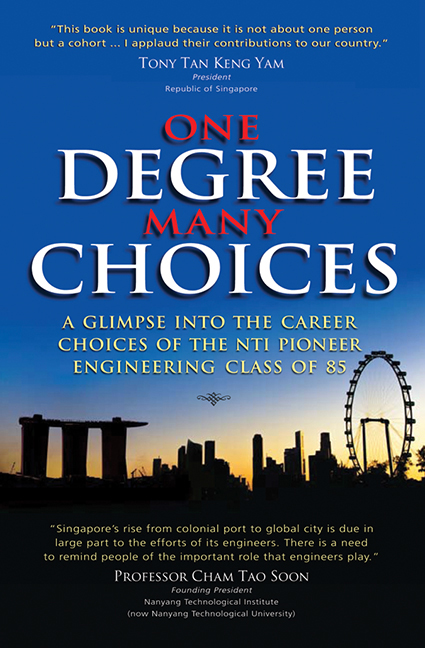 One Degree, Many Choices
One Degree, Many Choices from PART II - ENGINEERING PURSUITS
Published online by Cambridge University Press: 21 October 2015
“I must be competent as the implications of my findings were serious.”
— Eric Lim Tow Ghee, MPE PioneerAN AIRCRAFT DISASTER that nearly took place in Singapore in 2010 highlighted the importance of engineers in the aerospace industry. On 4 November, a Qantas A380 had to do an emergency landing in Singapore after an engine blew up. Engineers from jet engine maker Rolls-Royce scrambled to pinpoint and rectify the problem.
The massive publicity underscored the importance of the high-value, high-technology aerospace industry to Singapore's economy. An aircraft engine alone costs $12 million. Singapore, a major player in the global aerospace industry, dominates the Asia Pacific region with a quarter of the maintenance, repair and overhaul market share. The local industry had an output of $7 billion in 2009 and employs 19,000 skilled workers. More than 100 international firms operate here.
NTI pioneers contribute actively to the aerospace industry, an industry which Singapore has been promoting since the 1970s. MPE pioneer Ananda Senan Singaravelu spent almost his whole career in the industry. He started as a R&D engineer in 1986 developing new repairs for aircraft engine components. His lucrative initiative raked in millions for the company over 10 years. His career saw him take on many roles in operations, customer service and sales.
By the late 1990s, Ananda's company had a global market for their products. Its success caught the eye of Pratt & Whitney, a global engine manufacturer, which acquired it to beef up their business. Under the new management, Ananda headed the Operations Unit. In 2007, he went to their Global Repair Services division to set up new ventures in the region.
At Pratt & Whitney, Samuel Tang was part of the joint venture with Singapore Airlines to provide engine repair services. The highly experienced Samuel had worked for ST Aerospace, General Electric Aviation and Interturbine Singapore. His skills caught the attention of Hobart Airport System which opened their facilities in Singapore in 1990. The company which designs and builds hangars and airport power systems in Asia persuaded him to be their engineering manager.
General Electric Aviation is another aerospace bigwig. Eng Tian Soon was the Six Sigma specialist there. Six Sigma is a management system to optimise the performance of processes. Getting his Six Sigma Black Belt was not easy.
To save this book to your Kindle, first ensure [email protected] is added to your Approved Personal Document E-mail List under your Personal Document Settings on the Manage Your Content and Devices page of your Amazon account. Then enter the ‘name’ part of your Kindle email address below. Find out more about saving to your Kindle.
Note you can select to save to either the @free.kindle.com or @kindle.com variations. ‘@free.kindle.com’ emails are free but can only be saved to your device when it is connected to wi-fi. ‘@kindle.com’ emails can be delivered even when you are not connected to wi-fi, but note that service fees apply.
Find out more about the Kindle Personal Document Service.
To save content items to your account, please confirm that you agree to abide by our usage policies. If this is the first time you use this feature, you will be asked to authorise Cambridge Core to connect with your account. Find out more about saving content to Dropbox.
To save content items to your account, please confirm that you agree to abide by our usage policies. If this is the first time you use this feature, you will be asked to authorise Cambridge Core to connect with your account. Find out more about saving content to Google Drive.